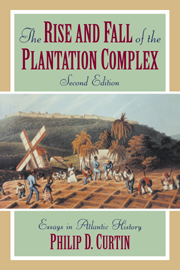Book contents
- Frontmatter
- Contents
- Preface
- Preface to first edition
- Beginnings
- 1 The Mediterranean origins
- 2 Sugar planting: from Cyprus to the Atlantic islands
- 3 Africa and the slave trade
- 4 Capitalism, feudalism, and sugar planting in Brazil
- 5 Bureaucrats and free lances in Spanish America
- Seventeenth-century transition
- Apogee and revolution
- Aftermath
- Appendix
- Index
5 - Bureaucrats and free lances in Spanish America
Published online by Cambridge University Press: 05 June 2012
- Frontmatter
- Contents
- Preface
- Preface to first edition
- Beginnings
- 1 The Mediterranean origins
- 2 Sugar planting: from Cyprus to the Atlantic islands
- 3 Africa and the slave trade
- 4 Capitalism, feudalism, and sugar planting in Brazil
- 5 Bureaucrats and free lances in Spanish America
- Seventeenth-century transition
- Apogee and revolution
- Aftermath
- Appendix
- Index
Summary
The post-Columbian opening of the Americas created opportunities and raised problems for European governments. The previous isolation of the Americas left them open to European conquest. The impact of European diseases made conquest easy, though the later die-off of the Indians greatly reduced the value of the prize. One problem, recurrent throughout the sixteenth and seventeenth centuries, was to create institutions capable of governing the conquered territorial empires. Another was to keep overseas Europeans under control. The growth of feudalism from below in Brazil was one manifestation of that problem. The Spanish met another in their effort to erect Spanish kingdoms on the ruins of the Aztec and Inca empires. The British, French, and Dutch were to encounter still others in the Caribbean when they sought to establish their own versions of the plantation complex.
True colonies were no easier to control, as the British found out when the thirteen North American colonies seceded in the 1780s – and as the United States discovered in the 1860s when the slave states tried to secede in their turn. Both secessions, successful or unsuccessful, were associated with the dissolution of the plantation complex. Though distant in time, they were also related to the conflict between military conquerors and imperial bureaucrats in the first decades of Spain's conquest of the American mainland.
- Type
- Chapter
- Information
- The Rise and Fall of the Plantation ComplexEssays in Atlantic History, pp. 58 - 70Publisher: Cambridge University PressPrint publication year: 1998

